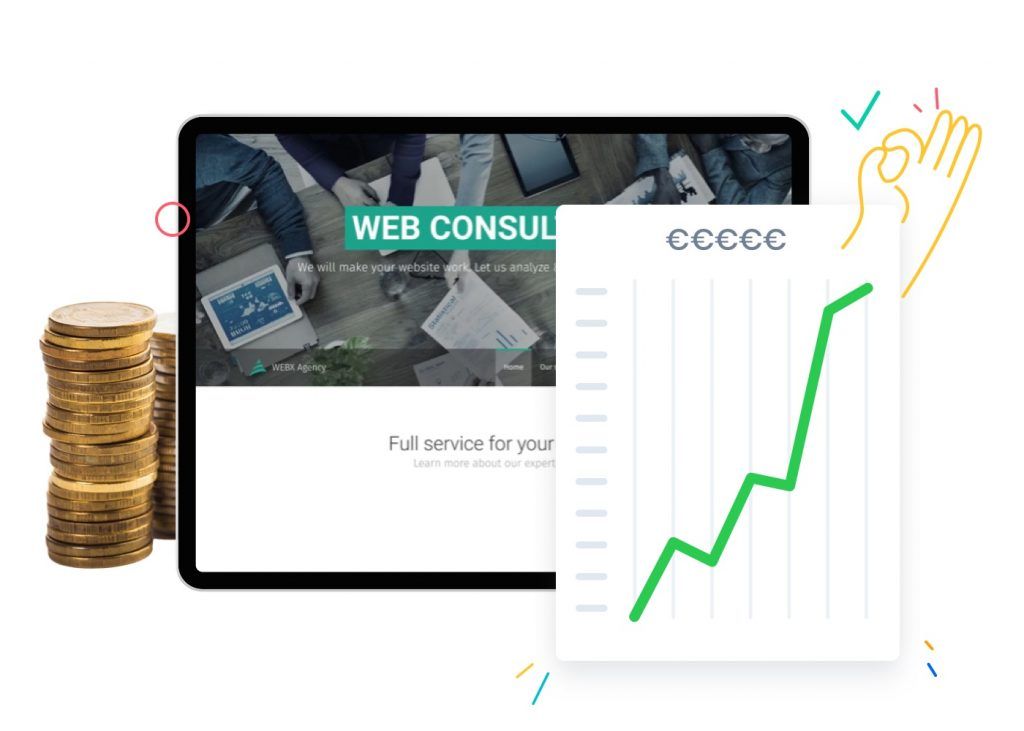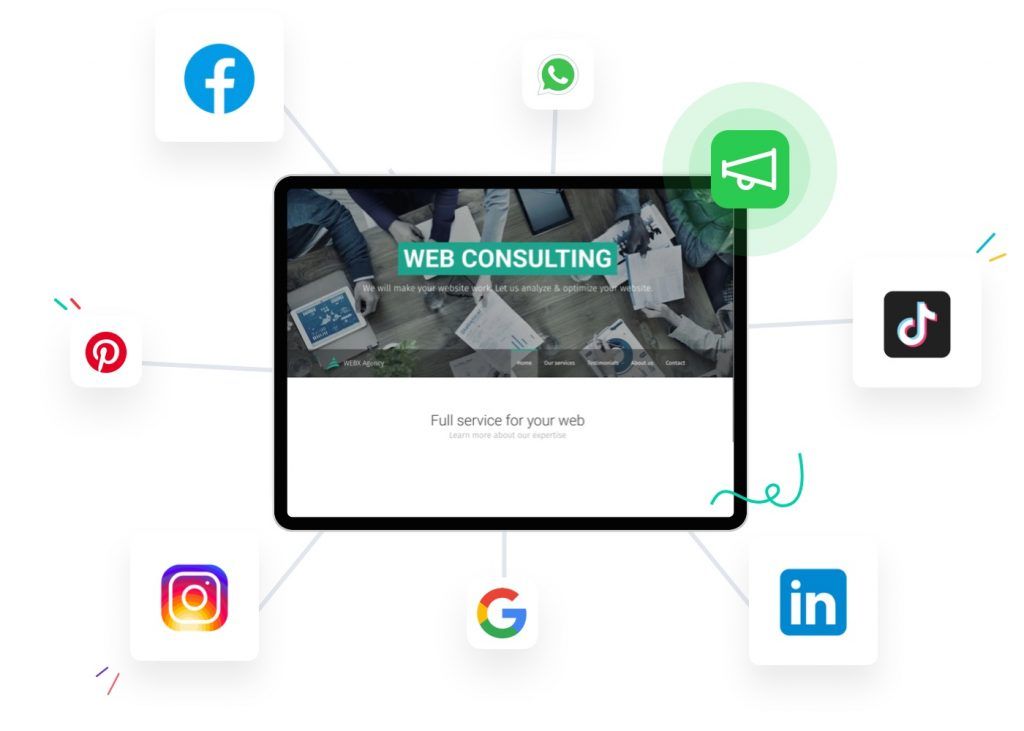Setting up a one-man business: how do you start?

Do you want to establish a one-man business and become a self-employed entrepreneur? It is important that you know the advantages and disadvantages of this form of enterprise, as well as what is involved in starting a one-man business.
- Starting a sole proprietorship in Belgium, what does that entail?
- Starting a sole proprietorship: the pros and cons
- Is starting a sole proprietorship right for you?
- How to establish a sole proprietorship? Start with the administration
- Starting a sole proprietorship:
- What about taxes, VAT, and social contributions?
- Charging and paying VAT
- Social contributions ...
- You're ready to start!
- Choosing a business name
- Let AI name your business
- Combell brings you online
- Your own website or webshop
- Don't forget the terms and conditions
- Promoting your sole proprietorship
- Best of luck with your business!
- Frequently asked questions about starting a sole proprietorship
Starting a sole proprietorship in Belgium, what does that entail?
We want to make sure that it is indeed a sole proprietorship (one-man business) you wish to start. Starting a sole proprietorship comes with specific conditions and obligations.
The Flemish government states that a sole proprietorship is a form of business. The type of business entity you operate under is crucial. This choice determines, among other things, the kind of accounting you must maintain, the taxes you pay, and the type of liability that applies to you.

If you want to become self-employed and start your own business, you can do so in Belgium in two different ways. There are two fundamental types.
Partnership?
A partnership equates to a company with legal personality. This is an independent enterprise that stands on its own legally. A partnership has its own rights, duties, and notably: its own assets, separate from those of the partners.
There are various types of partnerships, including a private limited company, public limited company, and a general partnership. These are just a few examples; you can read more about them on the website of the enterprise desk and social insurance fund Xerius.
Sole proprietorship?
You start a sole proprietorship as a natural person. Beware: in this case, there is no clear separation between your personal assets and those of your business.
This means that you are liable with all your assets, including your personal assets, for the risks associated with your business.
Starting a sole proprietorship: the pros and cons
Take it from us: you shouldn't set up a sole proprietorship without first weighing the pros and cons. We list the key advantages and disadvantages for you.
Starting a sole proprietorship: key advantages
Starting a sole proprietorship: key disadvantages
Is starting a sole proprietorship right for you?
Individuals who establish a sole proprietorship have one thing in common: they want to operate independently! Whether as a full-fledged independent entrepreneur or as a side business while maintaining a primary job with another employer.
Suppose you want to work as a freelancer or earn money from your passion or hobby in a side business... Then starting your own sole proprietorship is a good idea. Considering the pros and cons, it can also be suitable for those who want to become completely independent. 🙂
Be aware of what you're getting into. Both options involve significant responsibilities.

Quick to start
For those taking their first steps into the business world, a sole proprietorship is very handy. Setting up a sole proprietorship is relatively quick and easy. It requires less administration, the costs are manageable, and the bookkeeping is straightforward.
A sole proprietorship is thus ideal for those who want to get started quickly on their own, avoid a mountain of administrative paperwork, but still do everything by the book.
Example of a one-man business
Glenn is a passionate photographer from Sint-Niklaas who decided to pursue his dream and start a sole proprietorship. He founded 'Glenn's LENS' and works as a full-time self-employed individual. Although he bears all the risks associated with entrepreneurship, he can work independently, attract his own clients, and operate freely without the complexities of a corporate structure. He manages his own accounting and pays taxes through personal income tax. Since he needs to make a living full-time from this, Glenn might consider transitioning to a partnership in the future.
Have you considered market research?
Starting a sole proprietorship means you bear all the risks alone; you are solely liable. It's even more crucial to determine beforehand whether your business has a chance of success.
Turning your hobby into a profession is a great mindset, but if you want to sell homemade cakes, you need to ensure not only that the cakes are delicious but also profitable. 😉
Therefore, conducting some form of market research is a good idea. Ask yourself the following questions and seek out the answers:
Not sure how to start? Tap into your network, conduct surveys, do your research online, and see how competitors are doing it. This way, you can discover current trends and find ways to differentiate yourself.
Make sure to develop a business plan
While starting a sole proprietorship doesn't require you to submit a business plan... that's true. Yet, it's better to indeed prepare one. Use that plan as the roadmap for your business.
You can include your goals, plans, marketing actions, and financial status in it. A business plan helps keep your head cool. It’s something to refer back to when you’re uncertain about certain decisions.
With such a plan, you won't act recklessly. Thorough preparation is part of what makes a sole proprietorship successful.

How to establish a sole proprietorship? Start with the administration
Setting up a sole proprietorship involves several administrative steps. Let's go through them together.
Starting a sole proprietorship:
- Apply for your business number at the Crossroads Bank for Enterprises (CBO). This cannot be done directly but must be done through an authorized business counter.
- Activate your business number as a VAT number.
- Register with a social insurance fund.
- Apply for any necessary permits, depending on your business.
- Take out mandatory and additional insurance (liability, disability, etc.).
- Open a (business) bank account.
- Consider working with an accountant.
What about taxes, VAT, and social contributions?
Owners of a sole proprietorship must file an annual declaration via mandatory personal income tax. You will have to pay taxes on your net professional income.
This amount is what remains after deducting your professional income minus your business expenses (such as deductible costs). If you use a sole proprietorship to practice a side business, your salary as an employee and the income from your independent side business are added together. In some cases, this might push you into a higher tax bracket...
Not to forget: starting a sole proprietorship also means you will have to pay certain additional taxes. These range from local taxes to environmental levies.
Charging and paying VAT
If you own a sole proprietorship, you are typically required to charge VAT on your customers' invoices.
As a business owner, you also need to pay VAT, but you can offset this against the VAT you have already charged your customers. This is known as VAT deduction.
To pay VAT, you must submit periodic VAT declarations. The difference between the VAT collected from your customers and the VAT you paid needs to be remitted to the VAT authorities.
If your turnover does not exceed 25,000 euros excluding VAT, and your activity does not involve construction work on real estate, you are not required to pay VAT. More information can be found on this website.
Social contributions ...
If you are employed, you are not responsible for your own social security; it is handled by your employer through your salary.
As a self-employed individual, you must take care of your own social security. This includes building pension rights and receiving benefits in case of sickness and disability. Even with a sole proprietorship, you must manage all of these responsibilities by paying social contributions. More information can be found on the social insurance fund Acerta's website.
Those who are self-employed as their main profession must pay a minimum quarterly contribution to be insured. The situation is different for those with a side business. Only main-profession self-employed individuals and retirees can apply for an exemption from their social contributions—a benefit never available to those in a side business.

You're ready to start!
Have you obtained the necessary permits and licenses, are you following the correct environmental and safety regulations, do you know which invoicing software and accounting system you'll use, and have you mapped out what you need to market your products?
We could go on like this for a while... Those starting a sole proprietorship will soon find that there's a lot coming their way. But once all that is handled, you can truly begin.
Choosing a business name
You've chosen a good business name, right? You can't start without one. A name is crucial—it needs to resonate with potential customers, reflect what you stand for, and exude professionalism. Once you have a name, you can create a logo.
When choosing a business name, you also need to consider your business's online presence. Nowadays, you're nowhere without a website or webshop. But what if you choose a business name and the domain name is not available? You wouldn't want to experience that.
Your domain name is your address where customers can find you on the internet.
Register your domain name with a professional hosting company. At Combell, you receive numerous benefits and free extras.
Let AI name your business
Need help coming up with a good business name where the domain is still available? You can use our business name generator, designed to create unique names.
Just specify what your sole proprietorship stands for, choose the desired language, and play around with style and type. Afterwards, our AI tool will generate business names that align with your specifications—convenient indeed!
Start your venture with the right, memorable business name. You’ll receive various unique suggestions. Plus, you'll instantly see if the corresponding domain name is available.
Tip
Domain name already taken? Instead of the classic .be, opt for a different extension like .shop or .app. This way, you can still claim the domain name of your dreams. Check if your desired domain name is available.
Combell brings you online
You can't operate without a good website. As part of the digital world, your website serves as the business card of your organization.
Perhaps you even want to venture into online business by starting a webshop. How do you start a sole proprietorship with a webshop? We cover that too in our blog, in this article.
No matter how you approach it, before you can welcome internet users, you need hosting. This places your website or shop online. Combell is here to assist you; it’s our specialty. 😄
Compare different hosting providers and packages. There are very cheap providers available, but do they offer value for money? Choose a package that fully suits your business needs.
At Combell, you can count on reliable advice and free support. Here’s a tip: as a starter, a robust and professional base package goes a long way.

Your own website or webshop
This brings us to the next point: your own website or webshop. You'll need your own website regardless, which you can later expand into a webshop.
But you might want to start with a webshop right away. If you are selling homemade products, it makes sense to handle these sales online, entering the realm of e-commerce.
Also read
As you set up your sole proprietorship, you should consider whether you want your site or shop designed by web designers or if you prefer to build it yourself.
It's true that investments are required as part of starting a sole proprietorship. Costs for creating your website, design, a logo... all can be budgeted. But of course, you have a budget to consider.
The competitive pricing of Combell's SiteBuilder is a major advantage. Because I don't yet have the budget yet to outsource my website.
Greet, a starting children's and youth coach and a Combell customer
Sometimes you need to make budget-friendly choices. Perhaps you'll opt to build your website yourself. Greet Huys, one of our customers and a starting entrepreneur, knows all about this:
"I currently don't have the budget to outsource my website, and I'm certainly not the only one. That's why I'm very glad that Combell offers tools that allow you to build your own site quite inexpensively, which is helpful when you're not ready to make significant investments yet.”
Use our SiteBuilder
To create the website for her coaching practice, Greet used Combell's SiteBuilder. SiteBuilder is our golden tip if you want to go online quickly and on a budget.
This user-friendly package gives you everything you need to build your website immediately. And no, you don't need to retrain as an IT wizard. SiteBuilder is so cleverly designed that even complete novices can build their own site. Just look at how Greet’s turned out!
Building your website with WordPress
If you prefer more building blocks for your website, consider WordPress. Nearly 40% of all websites run on WordPress. That's why you can purchase hosting packages from Combell that come with WordPress pre-installed.
WordPress offers many advantages. It’s not just simple (free) Open Source Software, but you also have a choice of tens of thousands of themes and plugins. Many of these plugins can be installed for free. All these tools ensure that your website is up and running quickly.
Don't forget the terms and conditions
While you're at it, building your own website, it’s a great time to draft the terms and conditions for your sole proprietorship. Place them on your website so that customers are well informed.
In your terms and conditions, you can outline how payments are processed, the rights and obligations of customers, warranty periods, and the delivery timelines you offer. By establishing clear terms and conditions, you prevent misunderstandings and disputes.
If you sell products or services, you are always obliged to provide certain information, especially if you have a webshop.
Privacy policy on your website
In addition to your terms and conditions, you also need to include a privacy policy on your site or shop. This brings you into the realm of GDPR.
The primary reason for developing a privacy policy is, of course, that it's legally required. Anyone starting a website or webshop must comply with (European) laws and regulations.
A privacy policy is a crucial component in safeguarding the privacy of your users while protecting the reputation of your organization. Being transparent builds more trust with your visitors. Customers want to know which 'third parties' you share their data with, such as service providers, advertisers, or government agencies.
If you want to create your own privacy policy and cookie banner, we recommend iubenda. This compliance software, led by a team of international lawyers, is a sister company of Combell. You can expect the same level of service.
With iubenda, you generate all the necessary documents and tools, and they automatically stay in line with changes in the law.

Promoting your sole proprietorship
Once your website is live, it's time to promote your business. Use social media linked to your website for this purpose. Platforms like Instagram and YouTube allow you to advertise either for free or at a low cost.
Especially in the beginning, you'll need to find budget-friendly ways to promote your business. Word-of-mouth is crucial, but you can also distribute flyers, attend networking events, and organize small promotional activities...
Once your business is established, it's wise to experiment with online marketing and advertising.
Two effective ways to attract customers:
- Engage in email marketing by sending newsletters and promotional emails to subscribers. To do this professionally, use Flexmail. As a Combell customer, you can access this at a very advantageous rate.
- Consider lead generation for future investments. With tools like Leadinfo, you can discover which companies are visiting your website. Our customers can try Leadinfo free for 14 days and even receive a 15% discount on packages afterward.
Best of luck with your business!
We at Combell wish you tremendous success with your sole proprietorship. Hopefully, this blog has set you on the right path. With excellent preparation, you can make your sole proprietorship thrive and achieve your dreams. Go for it and build a successful enterprise!
Whether it's about hosting, domain names, or security options, you can count on Combell throughout your entrepreneurial journey.


